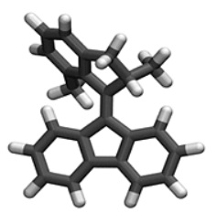Verrassende ontdekking onder de motorkap van moleculaire motoren

Onderzoekers van de Universiteit van Amsterdam hebben, in samenwerking met Nobelprijswinnaar Ben Feringa en Wesley Browne , beide van de Rijksuniversiteit Groningen, verrassende nieuwe details over de werking van licht-aangedreven moleculaire motoren ontdekt. Ze publiceerden hun resultaten deze week in The Journal of Physical Chemistry A. De redactie van dit chemische vakblad verkoos hun artikel tot 'Editor's choice'.
Uit de resultaten blijkt dat de moleculaire motoren van Feringa aan het begin van elke draaislag heel eventjes haperen. Dit is het gevolg van een niet eerder ontdekte 'dark state' van de motor. Het onderzoek biedt aanknopingspunten om via een aangepast chemisch ontwerp de efficiëntie van moleculaire motoren te verbeteren.
Aanzwengelen met licht
Feringa's motoren zijn de kleinste mechanische apparaten die de mens ooit heeft gemaakt: ze bestaan uit slechts een handjevol atomen. De Amsterdamse onderzoekers dr. Saeed Amirjalayer, prof.dr. Wybren Jan Buma en prof.dr. Sander Woutersen onderzochten licht-aangedreven motoren die uit twee delen bestaan, aangeduid als stator en rotor. Deze delen zijn via een zogenaamde dubbele covalente binding met elkaar verbonden. Normaal gesproken is zo'n dubbele binding star en weinig beweeglijk. Dat verandert in de eerste, cruciale stap van hun draaibeweging, als de motoren een UV-lichtfoton absorberen dat hen als het ware 'aanzwengelt'. Het idee was altijd dat de moleculen daarbij in een zogenaamde elektronisch aangeslagen toestand komen die de eigenschappen van de dubbele binding zodanig verandert dat de rotor en de stator wél gemakkelijk ten opzichte van elkaar kunnen draaien. Dat proces komt op heel veel plaatsen voor: in retinal-moleculen zorgt het er bijvoorbeeld voor dat ons oog licht kan waarnemen, en zonnebrandcrèmes zetten op die manier schadelijke UV-straling heel snel om in warmte.
Motor in 'dark state'
Om meer zicht te krijgen op de details van het aanzwengelen ontwikkelde Saeed Amirjalayer een manier om direct na de absorptie van het licht de structuur van de moleculaire motor te bepalen. Hij gebruikte ultrakorte pulsen infraroodlicht (van minder dan een biljoenste van een seconde) en mat daarmee hoe de trillingsfrequenties van het motormolecuul veranderen vlak na de absorptie van het UV-licht. Aangezien deze trillingsfrequenties direct gerelateerd zijn aan de structuur van de motor, kon hij zo supersnelle 'snapshots' maken van de motorstructuur tijdens de draaibeweging.
Volkomen onverwacht bleek dat de snapshots absoluut niet overeenkwamen met die van de motor in de veronderstelde elektronisch aangeslagen toestand. Met behulp van quantumchemische berekeningen werd duidelijk wat er wél gebeurt: de motor komt in eerste instantie weliswaar in de verwachte aangeslagen toestand, maar vervalt vrijwel direct in een ándere elektronisch aangeslagen toestand. Deze toestand is niet via de directe absorptie van licht te realiseren en wordt daarom ook wel een 'dark state' genoemd. Amirjalayer stelde vast dat de rotor en stator in die toestand slechts een heel klein beetje ten opzichte van elkaar gedraaid zijn. Pas als er een energie-barrière wordt overwonnen, wat enkele biljoensten van een seconde duurt, kan de motor verder draaien. Of de motor daarbij dan verder draait of weer terugdraait naar z’n oorspronkelijke stand (en dan dus eigenlijk niets gedaan heeft) hangt heel erg af van hoever de motor in de ‘dark state’ al is gedraaid.
Verbeterde motoren
Door de ‘dark state’ hapert de motor dus heel eventjes aan het begin van zijn draaibeweging en wordt z’n efficiëntie beïnvloed. Saeed Amirjalayer: ‘Die kennis is belangrijk voor het ontwerp van volgende generaties motoren. Daarbij is het zaak de optimalisatie van het aanzwengelen met name te richten op de vastgestelde 'dark state' en niet, zoals tot nu toe gedacht, op de eerder verwachte aangeslagen toestand. De resultaten van onze experimenten en berekeningen laten precies zien hoe je dat het beste kunt doen.'
Publicatie
Saeed Amirjalayer, Arjen Cnossen, Wesley R. Browne, Ben L. Feringa, Wybren J. Buma, and Sander Woutersen: Direct observation of a dark state in the photocycle of a light-driven molecular motor. J. Phys. Chem. A 2016, 120, 8606-8612 DOI: 10.1021/acs.jpca.6b09644
Bron: nieuwsbericht UvA
Meer nieuws
-
19 december 2025
Mariano Méndez ontvangt Argentijnse RAÍCES-prijs
-
18 december 2025
Waarom innoveren, en voor wie?
-
17 december 2025
Ben Feringa wint Feynmanprijs
